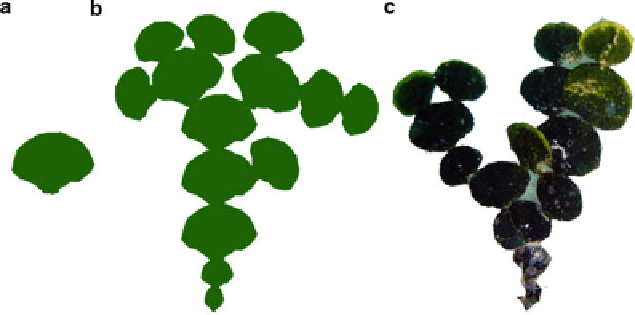Environmental Engineering Reference
In-Depth Information
Fig. 17.4
Halimeda tuna
- a single module as interacting components in the model (a) the
modelled growth pattern (b) and a photograph of the actual alga (c). Taken from Yniguez et al.
(2008)
individually depending on depth and shading effects of existing modules. At the start
of the simulation, the initial values for state variables and the number of model
organisms were set corresponding to field observations. The model used discrete
daily time steps. Each module had direct information of its position within the grid
and was able to retrieve/'sense' environmental parameters for both its own cell and
its neighbourhood. Based on this information, probabilities for growth (defined as
the production of a new module by an existing one) and growth pattern were
calculated and newly produced modules positioned. If existing modules were
situated at the edge of an alga they could be randomly selected for fragmentation,
which implied an additional mortality probability for the fragment. At the end of an
iteration the three-dimensional grid was transformed into a two-dimensional square
to calculate the percentage of cover for each species.
A total of 30 replicate simulations (each over a period of 1,000 days) per site
revealed striking similarities for morphometric characteristics of model
H. tuna
and
field data such as the number of segments per individual alga between different sites
and the relationship between growth (segment production) rates and depth.
H. tuna
from the deepest site featured the highest growth rates and the highest number of
produced modules per individual, while individuals of the shallowest site had low
growth rates and low numbers of segments. Despite small divergences between
model prediction and field data, the natural inter-site differences in growth mor-
phometrics were well reflected by the model. Due to its fine-tuned nature this
technique is not yet applicable to larger scale simulations mainly due to limitations
in computing capacity. Similar methodologies were already applied in the study of
plant architecture and morphology by utilizing so called L-Systems (see also
Chap. 11). This approach is novel in the marine context and can contribute valuable
information regarding small scale processes, which can be fed into larger scale
models when depicting natural variability.

